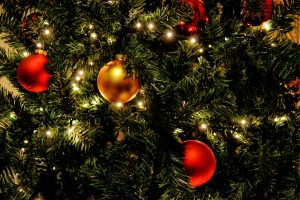December in the garden: Winter planning, Christmas tree care & sow early seeds

Wildlife Shelter
 A number of garden-visiting animals, such as hedgehogs, will be very grateful for a simple winter shelter to hibernate in. You can make one easily by using an upturned wooden box or tray with an entrance cut out, then putting a layer of dry leaves or straw inside and covering it with twigs. Make sure you wear gloves while you’re doing it otherwise the human scent might put them off.
A number of garden-visiting animals, such as hedgehogs, will be very grateful for a simple winter shelter to hibernate in. You can make one easily by using an upturned wooden box or tray with an entrance cut out, then putting a layer of dry leaves or straw inside and covering it with twigs. Make sure you wear gloves while you’re doing it otherwise the human scent might put them off.
Spread Manure
This is a good time to spread manure onto borders and vegetable patches. Cold, frosty weather will break it down into the soil to give nutrition for next year. You don’t need to dig it into the ground, as the weather should do this over the next few weeks.
Plant Lily Bulbs
If the ground is not frosted, this is a good time to plant lily bulbs in containers or borders.
Plant Supports
If you have a hazel or dogwood growing in your garden, cut some stout stems or twigs off them now, and stand them in your shed to dry out. They will be ideal for natural stakes or ‘pea sticks’ for supporting border plants next summer.
Moving Indoor Bulbs
Indoor bulbs will be ready for moving into the light now, but they will survive best if you first put them into a cool room for a week or so, before moving them into a heated room.
Test Your Soil
This is a good time of year to test the pH of your soil, which will tell you whether your soil is right for the plants you’re trying to grow and will also confirm any extremes which would make it difficult to grow certain plants.
Indoor Jasmine
Indoor Jasmine, with their scented white flowers, are among the most popular and rewarding plants at this time of year, but they do need to be looked after. Keep them away from draughts and radiators, and make sure their soil is moist but not over-watered, if you want them to flourish.
Conservatory Plants
If you have a conservatory or greenhouse with plants that are overwintering in a dormant state, you need to keep their soil moist with occasional and limited watering.
Protect Young Conifers
Many evergreen conifers suffer badly from freezing winter winds, which can ‘burn’ their foliage, and make it turn yellow or brown. To stop this, it is worth protecting them with netting by putting three or four stout sticks around the tree, wrapping the netting around it, and fixing with string.

Christmas Tree Care
If you have a cut Christmas tree, there is only so much you can do to maximise the length of time it will hold onto its needles. Buying a non-drop variety will help a lot, but in any case, if you spray the tree all over with a fine water sprayer, (before decorating if necessary) and make sure that the cut stump has access to water, it will take up some moisture and retain the needles for longer. Similarly, try and avoid standing your tree next to a radiator or heater.
Winter Planning
You probably don’t feel like being very active in the garden, but you’ve got plenty of time to walk round looking at it with its bare winter bones and making plans about changes you want to make in the coming year. It’s much easier to plan now than when everything is growing.
Leaves off Bulbs
Don’t let the remains of last year’s depressing gardening season spoil your early treats this year. It won’t take much mild weather for the leaves of early spring bulbs to push through – some already have – and they don’t like struggling with a covering of wet, rotting leaves. Ideally, gently clear the leaves off the site before the new growth appears.
Insulate Cold Frames
To make sure you protect young plants from extreme winter cold, modern cold frames, made of aluminium and glass, will benefit from having the gap between the glass and aluminium sealed up with an insulating foam such as bubble wrap or other suitable material.
Chrysanthemum Cuttings
The root clusters of chrysanthemums that you dug up and stored indoors for winter protection will be sprouting new growth now, and using cuttings from this growth, instead of replanting the old clump next year, will produce better quality new plants.
Sow Early Seeds
Some summer flowering perennials like an especially long growing period, in which case they will benefit from having their seed sown any time now – so long as it is in a protected spot, ideally in a propagator. Sow different seeds into pots and put them in the propagator.


















